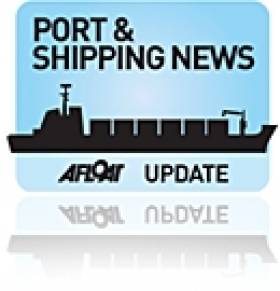Displaying items by tag: Spectacular Voyage
Newbuild: Arklow Bay’s 'Spectacular' Voyage Set in the Norwegian Fjords
#VoyageVideo - Arklow Bay, the second of six 'B' class cargoships with 'green' design credentials built for Arklow Shipping's Dutch subsidiary, is captured on video as she makes a spectacular passage through the stunning Norwegian fjords, writes Jehan Ashmore.
The speeded-up video footage courtesy of Chief Officer Lopatin, was taken last July from the Arklow Bay's bridge overlooking most her 119.49m hull. In fact the footage is made from thousands of photos made every 5-10 seconds and then combined into the film that follows her navigation through this stretch of Norway's vast rugged and mountainous coastline.
Channels dotted with islands are crossed by suspension bridges, inland lighthouses are trapped in fjords before the 'Bay' has finally reached her place of destination deep in the Nordic interior.
According to Lopatin, the 'Bay' berthed in Eikefet, to the north-east of Bergen, from where she made an en-route bunkering call albeit not shown on the video. With the ship berthed alongside the plant's jetty, watch the crew at work and as the deck gantry machinery opens the cargo hatch covers.
A conveyor-belt then gets into action to discharge stones that involves an overnight operation as the commercial world of shipping waits does not wait for anyone. In doing so, note the ship is shifted along the quayside pontoon in order to complete the loading into the separate holds from the fixed position of the conveyor.
Cargo holds filled, the Arklow Bay's work is done and she edges away from Eikefet at the foot of the mountain's cliff-face lined above with Alpine trees. Next port bound is Emden, Germany.
As she swings off the berth, another cargoship awaits to dock at the facility. Having 'ship-spotted' for many years, I recognised the vessel to be from the Bergen-based Wilson Fleet Management, a competitor of ASL that trades in the waters of north-western Europe.
To maintain market demand and ASL's track record of a running a modern 45-strong fleet of dry-cargoships, the 8,860 total deadweight Arklow Bay along with the final sixth sister (under construction) was contracted to Ferus Smit's Dutch yard.
The sleek streamlined 'bulb-less' hulled vessels will provide efficient cargo capabilities while on passage in varying sea-states compared to previous tonnage all since sold.
As previously reported on Afloat.ie, Arklow Bay, gave us another video spectacular!.... her sideways launch in Westerbroek in the 'lowlands' country.
Only months later, she would be operating in completely different surroundings with the backdrop of Scandinavian jaw-dropping peaks.
So this begs the question having also called to Dublin Port last October, where is the 'Bay' now?





























































